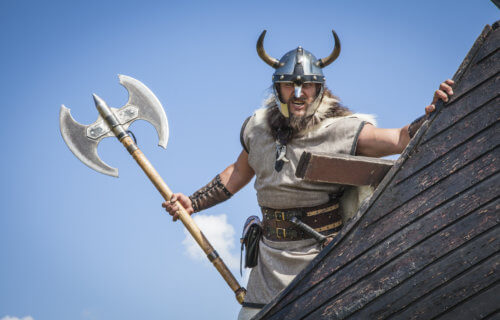BURNABY, British Columbia — For centuries, the iconic image of a Viking has been a ferocious, blonde warrior from Scandinavia with horns on his helmet. While our fearsome friend may have still had his classic helmet, a new study finds the origins of the Vikings is much more complicated. DNA tests reveal many of these warriors had brown hair and trace their roots to Southern Europe and even Asia.
Researchers from Simon Fraser University (SFU) say DNA from Viking skeletons finds the remains include people with more than just Scandinavian ancestry. The tests on 442 men, women, and children reveal many have genes from the British Isles, Southern Europe, and Asia. Two of the skeletons from a burial site in the Orkney Islands actually have a Scottish ancestry.
“We have this image of well-connected Vikings mixing with each other, trading and going on raiding parties to fight Kings across Europe because this is what we see on television and read in books – but genetically we have shown for the first time that it wasn’t that kind of world. This study changes the perception of who a Viking actually was,” says Prof. Eske Willerslev from the Universities of Cambridge and Copenhagen in a media release.
“No one could have predicted these significant gene flows into Scandinavia from Southern Europe and Asia happened before and during the Viking Age.”
Piecing together the Viking family tree
The international research team examined burial sites in Scandinavia, the United Kingdom, Ireland, Iceland, Greenland, Estonia, Ukraine, Poland, and Russia. Most of these historic locations date back to the Viking Age, between 750 and 1050 A.D.
Aside from finding many of these bodies don’t have a “pure” Scandinavian heritage, scientists say many were brunettes, not blondes. The study adds a Viking’s background tended to determine where those warriors sailed on their journeys. Vikings who travelled to England generally have a Danish ancestry. Most of the crews who went to Scotland, Ireland, Iceland, and Greenland seem to be Norwegian. Those who journeyed east mainly have a Swedish background.
SFU Archaeology Prof. Mark Collard adds DNA tests reveal another surprising fact about the Vikings — raiding other lands was a family business. Researchers find four members of a raiding party found in the same boat burial were all brothers. Two cousins were found buried in Sweden and a pair of second-degree relatives (half-brothers, a nephew and uncle, or grandson and grandfather) were discovered in Denmark and England.
“While the ‘big picture’ discoveries are great, I was blown away by the fact that the analyses revealed the presence of four brothers in the Estonian boat burial, and a possible nephew and uncle on either side of the North Sea,” Collard says.
“These findings have important implications for social life in the Viking world, but we would’ve remained ignorant of them without ancient DNA. They really underscore the power of the approach for understanding history.”
The study appears in the journal Nature.

what in the far left Liberal B.S is this?
Stay triggered, brad.
Go back to penning your manifesto, so the FBI can take care of you, ASAP.